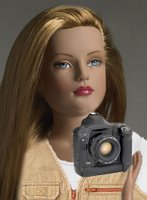Happy Hanukkah everybody, you know, from your friends Chunky Photojournalist Barbie and Joel who are not really Jews... just kinda of Jew-ish. Get it? Get it? Or Jew-esque. ;)
We went down to Queens tonight for AMAZING latkes made from scratch. My mother-in-law has casually mentioned in the past that she really worked hard learning how to cook all the traditional holiday foods and things when she and Marty were newlyweds, but I had no idea. She has SO been holding out on me for the past five years. Best latkes ever.
They had also pulled out their menorah and got out some yarmulkes from Joel and Brian's childhood, which I had never seen before, hand knitted by his mom. The little boy-sized yarmulkes were pretty cute, actually. It's kind of nice seeing my in-laws slowly bringing back holiday traditions that were just too sad to observe for so long.
Anyway, nearly a month ago, I was in New Dehli for Diwali, which is also called the festival of lights. In this case, the holiday is centered not on the victory of the Maccabees over the Syrians but of the return of Lord Rama, a Hindu deity who embodies ideal manhood and virtue, and his wife Sita, who is worshipped as an avatar of Lakshi, the goddess of prosperity.
Long story short, Rama was exiled for fourteen years after giving up his claim to Kosala, a powerful Indian kingdom during in the 6th century BC, in order to defend his father's honor. His brother and his wife Sita joined him in his exile, during which time Sita was kidnapped by Ravena, the evil monkey king of Sri Lanka. Rama fought a big war in order to get his wife back, which he did. She had been perfectly faithful and devoted to Rama and his supreme awesome husbandly-ness the whole time, which was swell, and they got to go home and rule the big kingdom that was rightfully theirs and live happily ever after, which was also swell.
So now, Hindus light candles to symbolically illuminate Rama and Sita's way home, to celebrate the returning of light over a period of darkness. Everyone wears new clothes, eat sweets and sets off fireworks, with stores holding big Diwali sales, and McDonalds billboards featuring happy children drawing the golden arches with sparklers.
Buildings are covered in twinkle lights and everywhere you look there are cardboard swastikas on signs wishing everyone a happy new year and whatnot. In Hinduism, the swastika is the ultimate lucky symbol, but from my Western perspective, the swastikas were incredibly creepy to see as part of holiday decorations, you know, ever since Hitler stole it, rotated about 45 degrees and made it the symbol of the Third Reich and everything. It's ironic that the swastika, which comes from the Sanskrit word "svastika," is now THE iconic representation of evil.
On the other hand, maybe it's not ironic after all. Just as Rama returned to his kingdom and took up his rightful place as its ruler, the swastika continues to be a symbol of all that is auspicious in India, as if to say, "Pay no attention to that psychotic fuckhead who killed millions of people in the 1940s with something that looked just like this on his armband. It was ours for thousands of years before Hitler came along, and it's good luck and meant to wish you well, and if Hitler had been a Hindu he would have the WORST rebirth ever, so have a happy new year, dammit."
So maybe It's downright fitting. Diwali is ultimately a big celebration of good over evil, of starting anew, reclaiming what was ultimately yours in the first place with honor and welcoming a new era of prosperity. Which- having an epiphany as I write this- so is Hanukkah, actually. So here you go. A video of the Diwali celebration in my hosts' home. (If it looks weird here, click on it to watch it on YouTube without any weird cropping.
Here's to festivals of lights, to observing traditions, to emerging from the darkness, to getting out old menorahs and yarmulkes after years of being sad. To miracles everywhere, and appreciating all paths to God.
Friday, December 03, 2010
Subscribe to:
Post Comments (Atom)


No comments:
Post a Comment